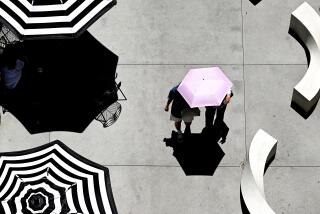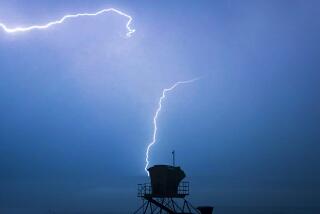When lightning strikes, here are the biggest dangers
Southern California saw an incredible lightning storm Tuesday night as the latest atmospheric river system moved in.
The rain will continue through Thursday, and although there is still a chance of thunderstorms, any lightning displays are likely to be far less dramatic.
The unusual weather has prompted people to ask what the basics are to staying safe during lightning storms.
People hoping to see any lightning display should do so from indoors, said Kathy Hoxsie, a meteorologist with the National Weather Service in Oxnard. Lightning can strike 10 or 12 miles away from a storm, she cautioned.
“It is dangerous for people to go outside and watch the lightning,” Hoxsie said. “People think they’re safe because it’s not on top of where they’re standing, but that’s not accurate.”
Here are some tips from the National Weather Service:
Indoors
Safe shelters are buildings with electricity and plumbing or metal-topped vehicles with the windows closed.
Picnic shelters, dugouts and small buildings without plumbing or electricity are not safe.
There are three main ways lightning enters structures: a direct strike, through wires or pipes that extend outside the structure, or through the ground.
Once in a structure, lightning can travel through the electrical, phone, plumbing or radio and television reception systems. Lightning also can travel through any metal wires or bars in concrete walls or flooring.
Here are some key safety tips for you, your pets and your home:
- Stay off corded phones. You can use cellular or cordless phones.
- Don’t touch electrical equipment such as computers, TVs or cords. Remote controls can be used safely.
- Avoid plumbing. Do not wash your hands, take a shower or wash dishes.
- Stay away from exterior windows and doors that might contain metal components leading from outside your home to the inside.
- Stay off balconies, porches and out of open garages or carports.
- Do not lie on concrete floors or lean against concrete walls.
- Protect your pets: Doghouses are not safe shelters. Dogs that are chained to trees or on metal runners are particularly vulnerable to lightning strikes.
- Protect your property: Lightning generates electrical surges that can damage electronic equipment some distance from the actual strike. Typical surge protectors will not protect equipment from a lightning strike. However, do not unplug equipment during a thunderstorm as there is a risk you could be shocked or electrocuted.
Outdoors
Try to get to shelter if possible. Listen to the weather forecast for the area you plan to visit. The forecast may be vastly different from the one near your home. If there is a high chance of thunderstorms, stay inside.
- Avoid open fields, the top of a hill or a ridge top.
- Stay away from tall, isolated trees or other tall objects. If you are in a forest, stay near a lower stand of trees.
- If you are in a group, spread out to avoid any potential electrical current from a strike from traveling between group members.
- If you are camping in an open area, set up camp in a valley, ravine or other low area. Remember, a tent offers no protection from lightning.
- Stay away from water, wet items such as ropes, and metal objects such as fences and poles. Water and metal do not attract lightning, but they are excellent conductors of electricity. The current from a lightning strike will easily travel for long distances.
Source: National Weather Service
More to Read
Sign up for Essential California
The most important California stories and recommendations in your inbox every morning.
You may occasionally receive promotional content from the Los Angeles Times.










